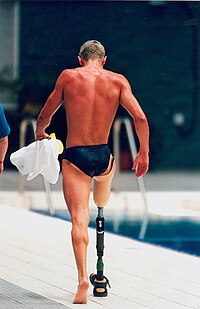
Photo from wikipedia
BackgroundAdvances such as targeted muscle reinnervation and pattern recognition control may provide improved control of upper limb myoelectric prostheses, but evaluating user function remains challenging. Virtual environments are cost-effective and… Click to show full abstract
BackgroundAdvances such as targeted muscle reinnervation and pattern recognition control may provide improved control of upper limb myoelectric prostheses, but evaluating user function remains challenging. Virtual environments are cost-effective and immersive tools that are increasingly used to provide practice and evaluate prosthesis control, but the relationship between virtual and physical outcomes—i.e., whether practice in a virtual environment translates to improved physical performance—is not understood.MethodsNine people with transhumeral amputations who previously had targeted muscle reinnervation surgery were fitted with a myoelectric prosthesis comprising a commercially available elbow, wrist, terminal device, and pattern recognition control system. Virtual and physical outcome measures were obtained before and after a 6-week home trial of the prosthesis.ResultsAfter the home trial, subjects showed statistically significant improvements (p < 0.05) in offline classification error, the virtual Target Achievement Control test, and the physical Southampton Hand Assessment Procedure and Box and Blocks Test. A trend toward improvement was also observed in the physical Clothespin Relocation task and Jebsen-Taylor test; however, these changes were not statistically significant. The median completion time in the virtual test correlated strongly and significantly with the Southampton Hand Assessment Procedure (p = 0.05, R = − 0.86), Box and Blocks Test (p = 0.007, R = − 0.82), Jebsen-Taylor Test (p = 0.003, R = 0.87), and the Assessment of Capacity for Myoelectric Control (p = 0.005,R = − 0.85). The classification error performance only had a significant correlation with the Clothespin Relocation Test (p = 0.018, R = .76).ConclusionsIn-home practice with a pattern recognition-controlled prosthesis improves functional control, as measured by both virtual and physical outcome measures. However, virtual measures need to be validated and standardized to ensure reliability in a clinical or research setting.Trial registrationThis is a registered clinical trial: NCT03097978.
Journal Title: Journal of NeuroEngineering and Rehabilitation
Year Published: 2018
Link to full text (if available)
Share on Social Media: Sign Up to like & get
recommendations!